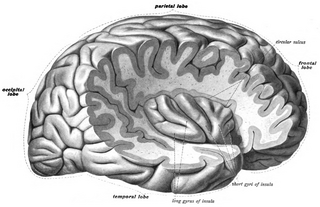| Periallocortex | |
|---|---|
| Details | |
| Part of | Allocortex |
| Identifiers | |
| Latin | Periallocortex |
| NeuroNames | 2315 |
Periallocortex is one of three subtypes of allocortex, the other two subtypes being paleocortex and archicortex. The periallocortex is formed at transition areas where any of the other two subtypes of allocortex borders with the neocortex (which is also called isocortex). [1]
The allocortex is one of the two types of cerebral cortex, the other being the neocortex. It is characterized by having just three or four cell layers, in contrast with the six layers of the neocortex, and takes up a much smaller area than the neocortex. There are three subtypes of allocortex: the paleocortex, the archicortex, and the periallocortex – a transitional zone between the neocortex and the allocortex.

In anatomy of animals, the paleocortex, or paleopallium is a region within the telencephalon in the brain which is older in an evolutionary sense than the archicortex and the neocortex.

In anatomy of animals, the archicortex or archipallium is the phylogenetically oldest region of the brain's pallium or cortex.
Thus, the periallocortex is also subdivided to two subtypes. One subtype is called peripaleocortex, which is formed at borders between paleocortex and neocortex. Areas considered to belong to peripaleocortex are for example anterior insular cortex. [2] Another subtype of periallocortex is called periarchicortex. It is formed at borders between archicortex and neocortex. Areas considered to belong to periarchicortex include entorhinal cortex, perirhinal cortex, presubiculum, parasubiculum, retrosplenial cortex, subcallosal area and subgenual area. [3]
Peripaleocortex is one of two subtypes of periallocortex, the other being periarchicortex. Peripaleocortex is formed at borders between isocortex (neocortex) and paleocortex. It shows slow histological transition from the three-layered structure characteristic of paleocortex to the typical six-layered structure characteristic of isocortex. The main peripaleocortex area is anterior insular cortex.

In each hemisphere of the mammalian brain the insular cortex is a portion of the cerebral cortex folded deep within the lateral sulcus.
Periarchicortex is one of two subtypes of periallocortex, the other being peripaleocortex. It is formed at borders between archicortex and isocortex and shows slow histological transition from the four-layered structure typical for archicortex to the six-layered structure typical for isocortex.
No one allocortex or even periallocortex area borders, contacts or transitions immediately to the so-called true isocortex. Instead, they border and slowly transition to another transitional area from the neocortex side, called proisocortex, which then slowly transitions to the true isocortex. Thus, at borders between isocortex and allocortex there are two transitional areas, one from allocortex side and histologically more resembling allocortex, so it is called periallocortex, and another from isocortex side, histologically more resembling true isocortex, so it is called proisocortex. [4]
Proisocortex or pro-isocortex is one of two subtypes of cortical areas in the areas belonging to the neocortex. The other subtype is termed the true isocortex. Proisocortical areas are transitional areas placed between areas of true isocortex and areas of periallocortex. The histological structure of proisocortex is also transitional between true isocortex and either peripaleocortex or periarchicortex, depending on with which subtype of periallocortex the given proisocortical area borders.
Those two transitional areas (one from isocortex or neocortex side, called proisocortex, and another from allocortex side, called periallocortex) together form what is called mesocortex. [5]
Mesocortex is the transitional areas of the cerebral cortex, formed at borders between true isocortex and true allocortex. Parts of mesocortex that lie closer to the true isocortex and have more resemblance to the isocortex in their cytoarchitectonics and histology, are called proisocortex. Parts of mesocortex that lie closer to the true allocortex and have more resemblance to the allocortex in their cytoarchitectonics and histology, are called periallocortex.






